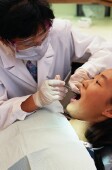
FRIDAY, April 23 (HealthDay News) — Breathing through the mouth instead of the nose can lead to more than just dry tongues and palates.
Chronic mouth breathers, most often children with allergies, have problems getting enough oxygen into their blood, which affects their size, weight, sleep and even school performance, a recent study finds.
“Mouth breathing is a medical problem that touches almost every family. It’s an unrecognized epidemic that needs immediate attention,” said study author Dr. Yosh Jefferson, a general dentist in Mount Holly, N.J., who has been treating orthodontia patients for more than 20 years.
“A lot of doctors will say that if you wait, it will just go away,” said Jefferson, who teaches and lectures on mouth breathing to spread the word, adding “it won’t just go away.”
Mouth breathing is caused by nasal obstructions, often the result of chronic infections and allergies. Consequences of untreated mouth breathing include unattractive facial and dental development, such as long face syndrome, narrow mouths and receding or protruding jaws.
Published in a recent issue of the journal General Dentistry, the study notes that mouth breathing is also associated with sleep apnea, a serious sleep disorder.
“They are suffocating and literally dying a slow death that robs them of their appearance, health, longevity and quality of life. Mouth breathing is very treatable, but to do this it must be diagnosed and treated as early as possible,” Jefferson said.
Allergy medications aren’t an effective treatment over the long run, because of undesirable side effects, said Jefferson. Mouth breathing is often corrected when tonsils and adenoids are removed, but this procedure isn’t done as routinely as it once was.
Mouth breathers who develop facial deformities need to wear corrective dental appliances, sometimes along with regular braces, to correct high vaulted mouth roofs, narrowing sinuses, and deformed jaws. Left untreated, more serious facial surgery can be needed.
But the complications of mouth breathing aren’t just physical. Shallow breathing causes insufficient oxygen in the bloodstream, resulting in fitful sleep. The children are tired during the day and perform poorly in school, often exhibiting anger and frustration typical of attention-deficit hyperactivity disorder (ADHD). As a result, they can be misdiagnosed with this condition.
Such was the case of a 5-year-old boy mentioned in the study. A mouth breather, he was often tired and not doing well in school. He regularly lost control of his behavior and had to be disciplined. But a year after he had his tonsils and adenoids removed and began wearing a functional appliance, his mother reported he was sleeping better at night, his behavior was normal, and he tested in the 99th percentile on a school-administered achievement test. He had also stopped bedwetting.
Humans swallow about 2,000 times day, causing the tongue to exert pressure on the roof of the mouth, widening the palate, Jefferson said. Mouth breathers don’t swallow as often because the open mouth tends to be dry. This eliminates pressure, causing the vaulting of the roof of the mouth. The longer the condition is left untreated, the harder it is to fix.
Dr. Leslie Grant, a spokesperson for the Academy of General Dentistry, said besides allergies, trauma at birth and Down syndrome can also cause mouth breathing.
Grant, who works in dental administration for the State of Maryland, thinks there may be a connection between mouth breathing problems and fewer tonsillectomies, once performed more routinely.
“I appreciate that he is bringing this issue to the forefront of the practice of dentistry because it’s important and often overlooked,” said Grant.
Jefferson describes his work as an effort to beautify facial features as well as solve health problems.
“If you harmonize the face the way God and nature intended, wonderful things can happen,” said Jefferson. “And it’s not rocket science.”
More information
For more on children’s dental health, go to the U.S. Department of Health and Human Services.

